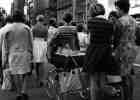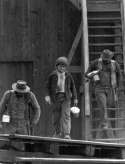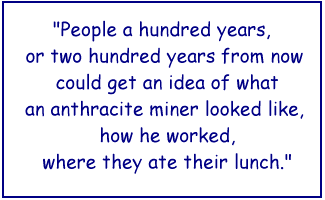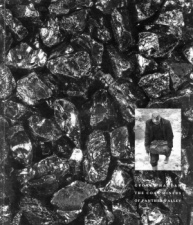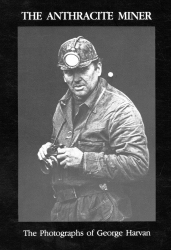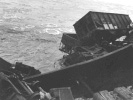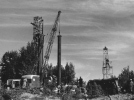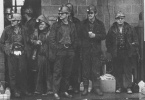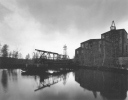of Photographic Projects, 1959-1995
Interview 1 | Interview 2 | Interview 3 | Interview 4 | Interview 5
|
Harvan: Each time I went to New York, in the early 60s, I was selling pictures to magazines or I had to take them in to show them around. Often they'd call me and and ask me to bring pictures in. I always took my camera with me. When I was through with my business in New York, I started photographing people on the streets of the city. I was fascinated with the people of New York, how they scurried from one place to the next, almost oblivious to each other. I felt that I should try to record the lives of people living on the streets. I often wondered where they were going and what was on their mind. I would take two or three rolls of film, usually, when I worked
|
Dublin: Do you have any thoughts, thinking back on it, how that project compared to your Tokyo work, before you left Japan? Because it was also city streets.
Harvan: It was very different, though, because in Tokyo I really wanted to show the face of people, and the people in Tokyo -- perhaps not all of them, but most of them knew I was taking their picture. I could stand in the middle of the pavement, and if I saw somebody coming toward me that I wanted to photograph, I had no intention of hiding the camera. I didn't fear, at that time, that I should because there was no one going to bother me. But sometimes if you point a camera at a person in New York, and if you don't know who you're pointing it at, you better be very careful. And then the results were so different -- different types of photographs.
Dublin: So there was a fair evolution in that group of photos, from when you started doing New York in just straight photographic, to being a bit more expressive.
Harvan: Right. You try to show the people in New York as they moved along the streets. Well, they were different type of people, also. As I said before, people scurrying around, going to different places -- home, work -- it seemed like everybody tried passing each other. I, sometimes, tilted the camera, so instead of having straight, uniform images, I'd have them cocked a bit, people walking on angles. It worked out quite well.
Dublin: So, what other projects, after the New York one, do you have in your portfolio?
Harvan: I think we should mention the work I did on the Molly Maguires, for Paramount Pictures. When Paramount came into this area to do the movie, they selected Eckley as one of their prime shooting places. Joe Boyle and I -- Joe Boyle was the editor of the Times News in Jim Thorpe at the time, in fact he owned it with his sister Gertrude -- decided to visit Eckley to see what was going on. They were in the process, then, of digging up the streets, and taking down all the wires to make this into a 1870 mine-patch town. And I started photographing the town, as it evolved into a movie set. And when Paramount people arrived, and when they first started to shoot at Eckley, I also took some still pictures of the sets. A few days later, I took my results and showed them to the PR person, and he remarked, "these are nothing unusual. Our photographer can do things like this." Well, I guess he was right. So, I went home and back into the darkroom. I dug out my grain screen -- it's a screen that you put down over your print, as you're exposing it. It gives you a real dirty, old look, a rough look. So I printed up a dozen or so photographs, and took them back up to the same person, and he said, "Well, now these are different." And as they were shooting the different scenes at Eckley, I was able to get close on each set. From that group of pictures, I compiled enough pictures so that I was able to put out a book on the Molly Maguires, a couple years afterward. The photos were shot in '67. I put the book out in '69. The photographs have that old nostalgic look to them, because of the grain screen. When the movie came out, and was going to be shown across the country, they used some of my photographs in their advance brochure, which they printed in black and white. The movie was done in color, but they printed the brochure in these stark black and white pictures. I remember reading a review in Argosy magazine, out of Chicago, I think. The fellow who did the writing couldn't wait to see the movie. He thought he was going see a great black and white movie, with the theme of the Molly Maguires, and their history. He was really looking forward to seeing the movie. When he walked into the theater, and it came on, and saw bright colors, he was disappointed and even thought he was in the wrong theater. He felt that if there was ever a movie that should have been shot in black and white, it should have been this one on the Molly Maguires. Like I said, with the theme of murders and labor violence, and intrigue, they kind of prettied it up. I found out later on they did it for television rights. It seems they get more to show a color film on television than they do a black and white one. But I got to know Richard Harris and Sean Connery and Samantha Egger and Marty Ritt, the director, and other supporting people.
Dublin:> What did you think about how that film interpreted the story?
Harvan: I was a little disappointed in it. I would have liked to have seen more scenes, when they were arrested, and in jail, and how they were coping with life in jail. Of course, some of the mine scenes, too, weren't very realistic. I imagine, for most people who never were in a mine, it never bothered them, but it bothered me. There was no mine scenes that were shot in this part of the country. The sets were made in Hollywood from photos and drawings. That's where all the indoor mine scenes were shot. And they looked it, too. I think if they could have used a real mine, like the No. 9 mine here, and filmed the mud and the dirt and everything else a deep mine reveals, they would have been much better off.
Dublin: My recollection, as I saw the movie some years ago, is that it makes an awful lot of this love affair. So much of it turns around a love affair, rather than turning around issues of discrimination or class differences. It loses the edge that the Molly Maguires had.
Harvan: Yes, it lost a lot of the flavor of the times. There was so much history written about the men, when they were awaiting trials, and they were awaiting execution, and the condition of the cells, the condition of the towns, the people, how they were reacting -- how the media was against the condemned men, it seemed everybody on the street was against them. Well, it wasn't a meaningful film. I imagine it was an entertaining movie to some.
Dublin: I know I was disappointed with how they handled it, and the feeling that it's not going to be made again very soon. So the opportunity was lost.
Harvan: And at the time, they spent a lot of money making it. I don't know what it cost -- sixteen or seventeen million -- which was a lot at that time. I expected something better.
Dublin: And it was Sean Connery and Samantha Egger. They had some of the leading film stars of the time.
Harvan:
Oh, sure, and
Richard Harris. And Marty Ritt at the time, was one of the top-notch directors.
So you had the people. James Wong Howe did the photography, and he's a
legend in Hollywood. They had good people there. But the script didn't
tell the story as it should have. It was written from a book by Arthur
Lewis.
Well, anyway, the pictures that I
took -- the pictures that I used in the book were actually not set pictures.
They were photos that I took between takes and down time. From this group,
I was able to compile enough images to go with song ballads from George
Korson's book, The Minstrels of the Mine Patch, portions which
I used underneath the pictures, and it worked out. The printing's not
that great, but adequate.
Dublin: So what you did, in a sense, is you told the story of the Mollies on your own, through this re-creation, when they were shooting on the set, and from the folklore.
Harvan: In the early part of the book, I used a lot of newspaper clippings, and told the real story as it unfolded. But I think what the photos revealed was the costumes of the period -- the children, and how they and the women dressed, and the miners' clothes in and out of work. That way, I was able to go along with stories and mine ballads. I mean, the sets were ready-made for me.
|
Dublin: Are there drawings from that time period? For instance, would like a Harper's Illustrated, or would Frank Leslie's Illustrated News have covered this event?
Harvan: I never saw any. I have never seen any photographs of the original Molly Maguire trials, or anything. The only pictures I have seen were taken by George Bretz, and they were portraits of the condemned men, in Pottsville.
Dublin: Oh, he did do that?
Harvan:
Oh, yes. George
Bretz was a Pottsville commercial photographer, and he did portraits of
the Mollies in Pottsville, but after the hangings in Pottsville, his studio
caught fire, and he lost all of the original negatives. The only thing
that remained of this work were some of the pictures that people had purchased.
He made cabinet type cards. It's too bad, what a waste. I mean, it's a
large part of history lost. We have got a pretty good idea what Campbell,
Doyle, and Kelly and others looked like from these photographs, but that's
about it. George Bretz was an interesting photographer. He was the first
photographer to photograph inside of a coal mine, and that was in the
Kohinoor Colliery, at Shenandoah.
Lantern slides appear to be the major
survivor of most of Bretz's work, because I understand he used to go around
to different community functions like those at fire halls, and he would
show the slides and charge admission. I think he had a group of these
lantern slides in his wagon that weren't destroyed by the fire. These
slides are at the University of Maryland [Baltimore County] in their collection.
Dublin: It was from those lantern slides that they made the prints in the book.
Harvan: That's right. In fact, Lance [Metz], at the Canal Museum, in Easton, has some lantern slides, also. So that's how I got into the Molly Maguire episode. And, as you mentioned, I doubt whether anybody could make a movie at present. I don't know if it would be salable or not, in this day and age. However, it's a fascinating story, the Molly Maguires.
Dublin:
It really is.
. . . I remember reading an account by Wayne Broehl about the time that
I took my orals at Columbia, years ago, so it was a story I was familiar
with.
Okay, why don't you talk a little
bit about some of the other places your work has been exhibited.
|
Dublin: And very appropriate for Lehigh University, which trained a lot of mining engineers over the years.
Harvan: It was strange, but it took a person like Ricardo, who came from Puerto Rico, to really realize the importance of the photos. Most curators, probably would not have bothered, but for some reason, he just latched onto the series.
Dublin: It took an outsider, not an insider.
Harvan: Yes. And maybe somebody who came from a humble background, or something, but whatever it was, he saw something important in the lives of the coal miners. He's been very enthusiastic about the book he just published about a year and a half ago, the catalogue of another show. He's very supportive of my work. Very supportive. I think I've had three exhibits at Lehigh, all told. And the last one was when the catalogue came out.
Dublin: Was that two years ago, now?
|
Dublin: What about your relationship over the years with the anthracite museum? Some of your work has been either shown there, or is permanently at Eckley, I think?
|
|
Harvan: Well, as everyone is aware, coal mining was a pretty dangerous occupation, especially the early days. You had men going into the mines using oil lamps, and carbide lamps, open flame lamps -- to see what they were doing. There was no other light down there. Through the years, there have been a lot of mine disasters. Huge ones, like the one up at Avondale, I think, in 1869. There was 122 killed there, and the twin shaft disaster at Pittston in 1896 -- twenty or thirty years later, fifty-eight miners were killed. And then the Baltimore Tunnel explosion in 1919, right after the first World War, ninety-four were killed. And through the years, there have been numerous smaller killings -- eight, ten, twelve, Janesville, the floodings, etc. Through the years there have been a number of explosions, fall-ins, fires, that cause deaths. I wouldn't say fortunate, but I was able, in my time . . . to photograph three of these disasters.
|
Dublin: That really is such a historic connection, because I know -- I'm pretty sure -- that Harper's, back in the 1860s, would have done drawings at the time of Avondale, and they would have shown the distressed wives of miners, waiting to hear what would happen. I mean, -- you do it in 1959 -- there is a hundred-year tradition in this region of these mine disasters, and of the family members anxiously awaiting what will happen. It is something that goes way back, and is so elemental to the life of a mining town.
Harvan: But there's so few photographs available of these disasters. Every now and then, you'll run across one, somebody will have printed it in the newspaper or magazine. But there were so few photographs or prints made in the anthracite region of the early disasters. I don't know if somebody like -- you mentioned Harper's, would have sent out an artist --whether that was big enough for them, but you would think it would be. Maybe there was other things that they thought were more important. . . .
Dublin: Well, what about Sheppton? That was one where I'd seen some of your photographs, of the Sheppton disaster.
Harvan: The Sheppton disaster was probably the most photographed and watched disaster in the anthracite region. I mean, due to the fact that television was just coming into its own, and the networks were covering it as a big news event. It was covered by each network and local T.V. station in the east. The foreign press was also here.
Dublin: Now this is August '63, right?
Harvan: Yes.
Dublin: How did you hear about this?
Harvan: I also heard about it on the radio. I heard there was three miners entombed at Sheppton. I was working for Bethlehem Steel at the time, and I believe it was a Tuesday. I was off that week, on vacation, when I heard about it, and I decided to see what was going on. Sheppton's not that far from Lansford. You go up 309, to Hazleton, branch off through West Hazleton, and then Sheppton's about three or four miles down the road. When I got there, lo and behold, who do I see but Gordon Smith, who was the chief mine inspector, handling the rescue. I had photographed Gordon many years ago. He was the foreman or Superintendent of the Gilberton Coal Company, at Gilberton. So we became pretty good friends through me making photographs for the company. I took along my 4x5 Speed Graphic. The rescue team was trying to send some miners down the slope, to see how far the cave-in was. They would go down part way, but they'd have to come up because they encountered gas, and falling debris. The mine was pretty well blocked up. I went back up to the mine the next day, and Gordon told me, "I don't think we'll ever find these men alive." I think over the weekend, Joe Bova, who was the brother of Louis Bova, one of the entombed miners, talked to Gordon, and felt that the crew should drill a bore hole at this one particular place, this one area. He had a pretty good idea of what the mine looked like and where they might be. I think it was a Saturday when they decided to drill a six-inch bore hole. After they got down to about three hundred feet, they placed a pipe down into this bore hole. The person -- I forget his name -- hollered down, heard a noise, and got a response. He got all excited and shouted, "They're alive! The men are alive."
Dublin: So the brother of the miner was saying to people, "If I'd been trapped under there, this was a place where I could have gone to."
Harvan: From later accounts, after they did come out, the three of them were together: Bova, Throne, I think Dave Fellin was 58 at the time, Louis Bova was 54, and Henry Throne, who had just worked there a few days, was 28. When they got trapped, the mine hadn't caved in all the way, and Louis Bova thought that he could find an escapeway, so he took off, and that's how he got separated from the other two. After the first six days they were down there, their lights died. Their lamps went dead. They were in complete darkness. They were in a space, maybe six foot long, and maybe about four foot wide. Very narrow place, some timbers had come down, and they were kind of bracing the roof, so nothing else would come down on top of them. They were in a very confined space, and when the word come out that the miners were alive, well, it spread like wildfire.
Dublin: This was about a week after the actual. . .
Harvan: Six days. And this spread from being a local event to a national news story. The first thing you know, the media converged on Sheppton. I called Life Magazine. I knew Ruth Lester, who worked with freelancers and stringers. I told her, "There's a big story breaking here, about the three miners who have been entombed for six days and have been found alive." She advised me to go and cover it. I made photographs until a couple days later when the office sent a Life photographer and a reporter to join me. The Life photographer's name was Gray Vilet, and reporter named Pollock. I forget his first name.
|
Dublin: How many did they finally print?
Harvan: I think they just used one of mine. I think they only printed about three or four pictures, but they were noted for that. I mean, if a new story broke and it took precedence, they just cut it. That was the big gripe among the staff photographers. I talked to Gray many times, up at the Hotel Altamont at night, and that was their biggest disappointment with the job. He would go out and shoot stories for weeks and it wouldn't run. They always found more important things to run. But that's the way Life did things. They had so many photographers, all over the world, exposing film, and they only had one magazine to use it in.
Dublin: What are the photos that you remember from that work that you're particularly proud of, or you think captured something that you wanted to communicate to people?
Harvan: Oh, I think most -- the ones I really like are the ones of Mrs. Throne and Fellin, and other members of the family, revealing the anxiety and wondering whether they would see the trapped miners alive again, being consoled by a priest or a sister. These were moving moments. Actually, there wasn't that much more to photograph besides the actual work. The big story was underground, which we had no control over. Also, it was interesting to show all the people who got involved, like the Navy personnel. They got very involved in learning how people can survive underground for fourteen days. They had teams of medical people on the site. They brought in the cameras that they could drop into the opening. After they enlarged the hole, they lowered a camera down in order to view the inside of the chamber. This was all revolutionary in those days. And, of course, the night they were going to bring the men out, it was like a circus up there. I mean, there were so many lights on, it was like a city street. Gray told me, "George, there's no sense in both of us being here. Why don't you go up to the hospital. When they bring the men in, you might get some shots as they wheel them in. So I got in the car, drove up to the gate, and a state cop stopped me and asked, "Where are you going?" I said, "I'm working for Life Magazine, and I want to get into the hospital." He said, "Follow me." Being with Life must have carried an awful lot of weight, because he took me all the way up, past everybody, and placed me right in front of the big network cameras. When they brought the two men down the aisle, on stretchers, I was able to get some good photographs. That was a big event. I doubt whether we'll ever see an event in the anthracite region that will ever be covered like that again. It's not so much that there were so many men killed, it's because they were down so long, and they were found alive and crews were drilling holes bigger and bigger so that eventually they would be big enough to squeeze them out. They used harnesses around them and then lifted them out. They had to figure out which harness worked best -- they tried different devices. I imagine all the survival people learned a lot. They were all over the place. And of course, the union people were there, Tony Boyle among them.
Dublin: Did they ever have an investigation and determine what caused the cave-in?
Harvan: It wasn't an explosion. It was just a fall, probably weak timbers or something like that. . . . It was away from them, but they couldn't get out past the blockage. I think it was right after that when the state demanded that every mine have a second escapeway. I think if they would have had a second escapeway, it would have made a difference.
Dublin: This mine was a tiny operation?
Harvan: Yes, it only employed four people. There was a man who hoisted the cars, a man by the name of Walker, and the other three men, that's all. The tipples were very crude, a small slope, the cars that took the coal out of the mine were very small. It was a small operation, but Fellin was a miner all his life. It was in his blood. Henry Throne believed and even said if it wasn't for Dave, he would have never made it. He pulled him through. If you work in a mine, I don't know how many weeks or just a short time, and all of a sudden you get trapped, and you're twenty-eight years old, it's a totally different situation. . . .
Dublin: Tell me about the Tower City disaster, because that's not one that I really know about. You mentioned it being the last one you covered.
Harvan: Tower City was in March of 1977. It was a day almost like Port Griffith, not quite as cold, but it was in March. That disaster was also caused by a flooding. Evidently some water had built up in the dam in one of the old workings, and then when the men entered the gangway, the water, instead of breaking in from the ceiling, broke in from the bottom and started to flood the mine. I also heard about that on the radio. I found out where Tower City was and decided to go there. I spent a number of days photographing the rescue teams who were hoping to get the men out. They did locate a fellow by the name of Ronald Adley. Evidently, he got up into an air pocket, where the water hadn't reached, and he was able to get enough air to survive. After they did locate him, we were notified. Everyday they would go in with different crews to try to clear enough debris to get him out safely. The press was staying up in a trailer which the state brought in, and that's where we slept. One evening the rescue people said they were going to bring Adley out at nine o'clock the next morning. When you're sleeping in a trailer, you don't get too much rest. So, I got up early and with another fellow, a photographer from The Reading Eagle, headed for the tunnel mouth and after a while, we see a series of lights coming toward us, and they were getting bigger and bigger. Adley had decided he didn't want to be carried out. He wanted to walk out, and when he walked out of the mine, we were able to get photographs of him as he emerged from the tunnel.
Dublin: So the lights you were seeing were the lights of miners who were coming up the slope?
|
Dublin: Was there a similar vigil there, as there had been at Sheppton and Port Griffith?
Harvan: Oh yes, but not as big. It was a lot more subdued. Sheppton was unique. The Red Cross was present as always, and also the Salvation Army, and various news people.
Dublin: How many people were trapped at Tower City?
Harvan: I think it was nine, and eight were drowned, but their bodies were found. They never did find Louis Bova.
Dublin: Was that your last major mine disaster in the anthracite region?
Harvan: Yes, there have been some smaller ones, one or two killed by a piece of machinery or a fall of coal or rock. I think that was the last disaster, the sort we'd call a major disaster in the region.
Dublin: With the kind of drama of waiting to see if people would be rescued.
Harvan: Yeah, you will always have the relatives and the family members doing the waiting and praying. You could just shoot so much of them. You can't start aiming your camera at their faces too often. You've got to give them a little privacy. You have to be very careful of what you're doing. That was the last one I photographed. But one thing I'm proud of, I do have a little record of the three disasters on film. Some aren't great pictures, but they are a record of that time. It's something I treasure.
|
"I
think to be a documentary photographer you,
|
Harvan: I guess just through books and magazines. As I mentioned, I never went to any photo schools, or college. And when you live in Lansford, there's not many people you could really talk to about photography, especially documentary photography. I learned mostly from magazines and a few books. You read about Walker Evans, he was a great photographer, an FSA photographer who did photographs in the Lehigh Valley, and down south before the war. He also did the photos for James Agee's book -- what's the name of the book?
Dublin: Let Us Now Praise Famous Men.
Harvan: Let Us Now Praise Famous Men, and when you look at the photographs, you learn. You learn from books and you learn from looking at other photographers' work. As far as any mentors, I never had any. The Museum of Modern Art once had an exhibit by Walker Evans, which impressed me very much. Maybe it was just your background, or what you went through so far in your life, and what you've seen and experienced in the mines and in the service. Maybe it's all documentary in nature, and so you just applied it to your photographs. Maybe there's no reason at all for it, really, just that you apply what you see and what you feel, and you decide to take a picture of the situation. Whether some people say, "This is a documentary photograph," it could be, perhaps not, maybe it's just a slice of life. If that's what constitutes a documentary photograph, well so be it. I don't know how it evolved, probably just moved from one day to the next, one situation, one event, to the next. And for some reason, you are compelled to photograph it. That's about the only reason I can give. I think to be a documentary photographer you, more or less, observe life and observe what's going on about you, constantly. Whether you want to write, photograph it, or paint it. I think you've got to experience life deeply.
Dublin: It sounds like you, in your description of your last months in Japan, that you had a desire to photograph the life around you.
Harvan: That started to evolve -- that's what I said. From then on, I think it was just a gradual progression of different events -- through the years, that you apply this documentary ethic, or whatever you want to call it, to your photographs. I think that's probably the way it started.
Dublin: Do you think your sister Rose was an influence on you, a bit, in this?
Harvan:
Not really. I
knew she photographed a lot. The only pictures that I saw were the photos
in the book she did with John Steinbeck, called The Forgotten Village.
I was aware of those photographs, but I also realized that these were
done for a film. They were done as a part of a movie set, so they weren't
actually documentary pictures. They had the feeling of a documentary movie,
but some of the photographs were set up, and I don't think they were true
documentary photographs.
No, my work was a lot different from
photographs that Rose did. But I imagine her being a photographer might
have had something to do why I wanted to be one also. I think probably
that if she hadn't been a photographer, I might have never pursued it.
That's probably the way it happened. I don't know if I had gone to a journalism
school, or studied photography with somebody, whether things would have
worked out better, or differently, I don't know. It's hard to tell. Rose,
when I came out of the service, I guess I was just out a few months, even
before I started for the Morning Call, she arranged for me to see
a man by the name Ralph Steiner in New York City. He happened to be a
great photographer, and a pretty well-known teacher. I never did get to
New York to see him. She thought it would have been good for me to look
him up. He did a lot of good work. I have seen his work throughout the
years, in many magazines.
Dublin: How has photography changed in terms of what you see being done around you, the kind of work that's being done and being published?
Harvan: Well, living here in Lansford, I'm not too familiar with other photographers. I've got to know people like Joe Elliott who teaches photography at Muhlenberg College. Joe did a lot of pictures in Bethlehem Steel. He portrayed Bethlehem Steel as a big company, which it was, and all his photographs revealed these majestic monuments -- big blast furnaces and long buildings. Very nice photographs, but he didn't show much of the workers, either. He left out the people in most photographs. He's leaving that up to the viewer to imagine who's working in the plants. You could imagine somebody working by the hot furnaces, but he left out the human element. I heard one fellow who had worked in the steel mills, remarked, "Steel plants were not like that. They were like David [Kuchta] talked about in his book. They were dirty, and hot, and steamy and really miserable places that you couldn't wait to get out of. They weren't monuments. It's just like the recent pictures that I took at the three remaining coal breakers.
|
Dublin: You got some photographs at the bagging plant at one of the breakers, didn't you?
Harvan: Yes. That included Joe Lawson at Locust Summit. He's the last remaining worker of the Reading Coal Company in that area. And they had thousands and thousands of people employed there at one time.
Dublin: And he's bagging coal now.
Harvan: Bagging coal, that's all he does. There's a certain stillness about an inside of a big breaker that's hard to explain especially when you're the only person in there walking around. It goes back to the same feeling you get, like, I mentioned in Gettysburg or some other places that I have photographed. You kind of visualize people still in front of you, working or sitting, picking slate, throwing the slate or rock down a chute. I think if you'd inject some of that feeling into your photographs, you put a little bit about yourself into each scene.
Dublin: I think that's an important thing that's obviously, from the very beginning in your work, the connection you've had, what drew you to the mines was the miners, and the experience of the miners.
Harvan: Yeah, I was never really interested in how many cars of coal they put out, or how many feet they had to drill in the vein. I primarily went in a mine there and looked for a certain type of photograph. If I could make that photograph, I was satisfied. Some people around here got really involved in coal mining procedures. They knew all about the mines and other workings. There's people who know a lot more about mines than I do. I'm not talking about miners. I mean ordinary people, because they study books about mining. I was so preoccupied to get a meaningful picture I didn't care what they were actually doing, as long as it was something that was interesting and I could make a photograph. That's all I primarily cared about.
Dublin: That's clearly your approach, and I think that's, in the end, your contribution, especially the shots you took over the years at Lanscoal, when you're in fact capturing miners at work. One will understand the process by how the men did it, and not just as a part of a technology.
Harvan: Yes. And you try to inject a lot of these feelings into photographs, even how they must smell. Sometimes a photograph can reveal a piece of clothing and the odor it must give off. Pretty bad, or something like that. There are many different odors that make up the air in a coal mine.
Dublin: You get close enough to it, and you can see it coming, encrusted and what not.
Harvan: I've had a lot of reviews on my work in the mines in the past. Some writers and people seemed to have gotten that same feeling, too. At the second show I had in the Wilson Gallery at Lehigh University it was during their alumni reunion, affair. An elderly couple from Brooklyn, after viewing my photographs encountered Ricardo [Viera] who put the show together. He told them that the person who took the pictures was present and he pointed me out to them. They came over and told me how much they liked the photographs. They also said, "You know, we were never really a big fan, or never thought much of John L. Lewis, but after looking at these photographs, we feel he might have had a point." The photographs did make people think and show the makeup of a mine, maybe how dirty a mine was, and what the miners had to endure. They also said, "I'm glad I didn't have to do it." So, if that feeling comes across, I guess maybe I've succeeded in a little way.
Interview
1 | Interview
2 | Interview
3 | Interview
4 | Interview
5
|
|
|
|
|
|
Miner's Son, Miners' Photographer: The Life and Work of George Harvan |
